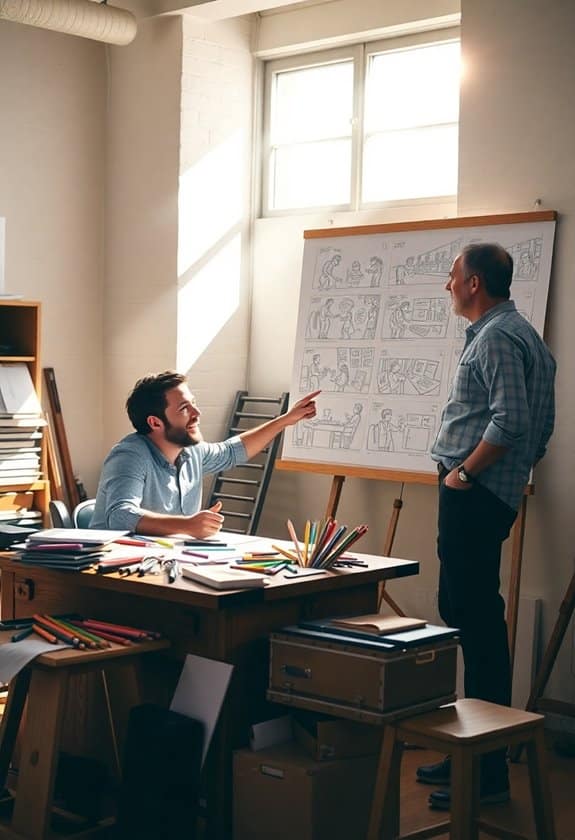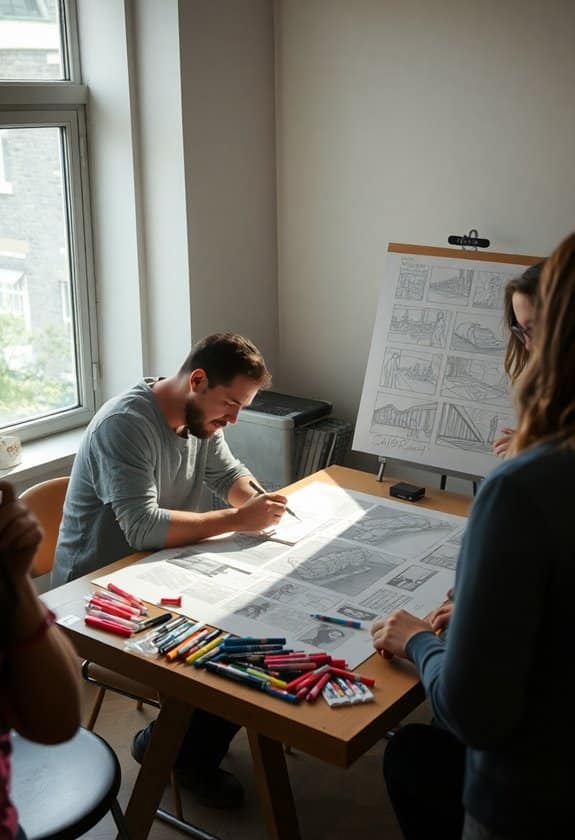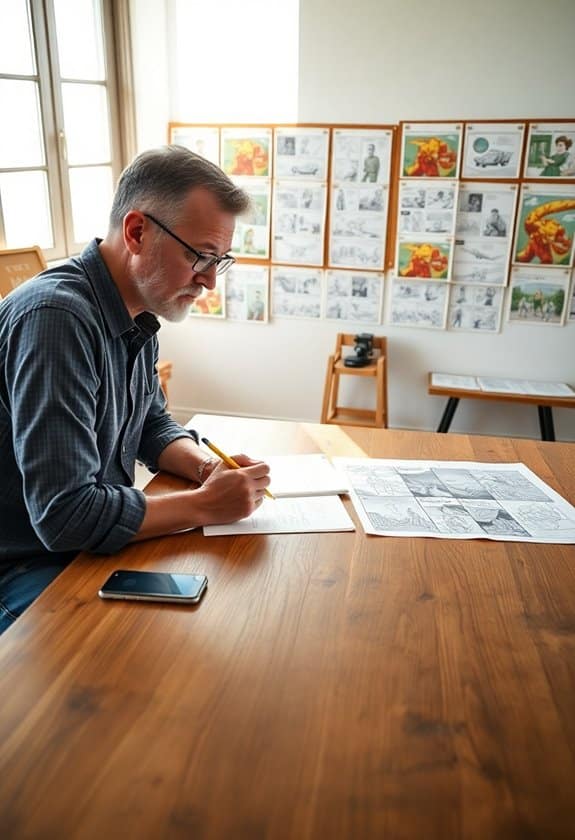When you’re working with storyboard artists, it’s like setting the stage for an epic adventure. First, make sure to define your vision clearly, sharing the story’s themes and mood. Ever tried describing your dream ice cream sundae? It’s kinda like that! Open communication is a must—let ideas flow freely, and maybe throw in a few brainstorming sessions too. Respect their expertise; they’ve spent years honing their craft. Give feedback that’s helpful but kind—like guiding a friend during a video game level. Finally, encourage creative collaboration, because teamwork makes dreams work! There’s more to explore on this artistic journey ahead.
Important Highlights
- Clearly define the main themes and tone of your story to align visuals with the narrative.
- Foster open communication and create a safe space for sharing ideas and feedback.
- Respect the expertise of storyboard artists and value their creative input.
- Provide constructive feedback, highlighting strengths before suggesting improvements.
- Encourage creative collaboration by involving artists early and embracing diverse perspectives.
Define Your Vision Clearly

To effectively collaborate with storyboard artists, it’s essential that you define your vision clearly from the outset. Imagine trying to build a treehouse without a blueprint. You’d end up with a wobbly mess!
Start by sharing your story’s main themes and tone. Is it an adventurous, heartwarming tale or a mysterious thriller? Your artist needs these details to guarantee the visuals match your story’s mood.
I once worked on a project where the artist thought we were creating a comedy, but it was a serious drama! We laughed about it later, but it taught me to be super clear.
Use reference images if you can, and never shy away from describing what you see in your mind. Your clarity guarantees a safe, smooth creative journey.
Foster Open Communication

Effective collaboration with storyboard artists thrives on open communication. Envision this: you’re excited about your project, but keeping ideas bottled up can lead to misunderstandings.
Share your thoughts openly, and encourage the artist to do the same—just like when you swap stories with a friend. This creates a safe environment where everyone feels heard, and trust naturally grows.
Imagine you’re both in a friendly brainstorming session. If something doesn’t make sense or you have a fun idea, speak up! A simple “What if we tried this?” can spark creativity.
Respect Their Expertise

Storyboard artists bring a wealth of experience and unique skills to the table, so it’s crucial to respect their expertise.
Imagine trying to capture a thrilling scene from your favorite movie—it’s not as easy as it looks! These artists transform scripts into visual stories, helping directors see their vision come to life.
By acknowledging their talent, you not only make them feel valued but also create a safer space for creative expression. Remember, they’ve spent years honing their craft, much like a seasoned chef perfecting a dish.
Trust their instincts; it’s like having a guide in a mysterious forest. Their insights can prevent potential pitfalls in storytelling, ensuring your project stays on track and safe from unexpected surprises.
Provide Constructive Feedback

Often, providing constructive feedback is essential when collaborating with storyboard artists. Imagine you’re working with an artist who’s just poured their heart into a storyboard. You’ve got to be careful, like handling a delicate piece of art.
Start by highlighting what you love about their work. It’s like buttering toast—smooth and warm. Then, gently suggest improvements, focusing on how they align with the project’s goals. “Hey, maybe this scene could use a bit more excitement?”
Keep your tone friendly and supportive, making sure they feel safe exploring your ideas. Remember, everyone loves a good story, and it’s your job to help make it shine.
With kindness and clarity, your feedback will guide them without overshadowing their creativity.
Encourage Creative Collaboration

Fostering an environment where creativity thrives can make all the difference when working with storyboard artists.
Remember the time when collaboration brought your vision to life? Here’s how to encourage creative teamwork:
- Open Communication: Always keep the lines open. Share your ideas clearly and encourage artists to voice theirs. It’s amazing what a simple chat can spark!
- Respect Different Perspectives: Everyone sees the world uniquely. Embrace these differences and watch your project bloom.
- Involve Them Early: Invite artists into discussions from the start. They might just have the perfect solution to a challenge you’re facing.
- Celebrate Successes: Acknowledge every win, big or small. It builds a safe space where creativity can truly flourish.
Frequently Asked Questions
How Do I Find a Reputable Storyboard Artist for My Project?
Finding a reputable storyboard artist can feel like a treasure hunt, but you’ve got this!
Start by asking filmmaker friends for recommendations; personal connections are gold. Check online platforms like Behance or LinkedIn, where artists showcase their work.
Look for portfolios that resonate with your project’s vibe. Don’t shy away from reaching out with questions about their process.
What Is the Typical Turnaround Time for Storyboard Creation?
Imagine the excitement of seeing your ideas come to life on paper!
Typically, a storyboard artist might take one to two weeks, depending on complexity and detail. You’ll want to give them space to work their magic, ensuring they capture every nuance safely.
I once waited enthusiastically, like a kid before a big game, and it was worth it. Communicate clearly, and you’ll get your vision perfectly sketched out.
How Can I Budget Effectively for Storyboard Artist Services?
Budgeting for storyboard artists might feel like solving a puzzle, but don’t worry, you’ve got this!
Start by setting a clear project scope. It’s like mapping out your journey before a road trip.
Consider the artist’s experience; more experienced ones might cost more but work faster.
Always ask for a detailed quote and factor in revisions, like packing extra snacks for unexpected detours.
This way, you’ll keep your project on track and your wallet happy!
Are There Any Specific Tools or Software Preferred by Storyboard Artists?
When you’re diving into the world of storyboard artists, it’s like stepping into a tech wonderland.
Artists often love using tools like Storyboard Pro and SketchUp. These programs are like magic wands, helping them create visual stories safely and efficiently.
Imagine painting your ideas with just a few clicks! It’s essential to find out which tools they’re comfy with, kinda like asking a chef which pan they prefer.
It keeps everything smooth and fun!
What Should I Include in a Storyboard Artist Contract?
They say, “Better safe than sorry,” and it’s true for contracts too.
You should include clear terms, like scope of work, deadlines, and payment details. It’s essential to outline revisions and ownership rights, so everyone’s on the same page.
Once, I forgot to specify revisions, and boy, was it a learning curve!
Keep communication open, and don’t forget to add a confidentiality clause—trust me, it keeps everyone feeling secure.



